Galicia is a Hawaii-sized state autonomous community on Spain’s northwest corner. I asked Spaniards if I should visit. “¡Por supuesto!,” said they, while suggesting that Galicia would be:
(♦) Beautiful! Woodsy green hamlets fronting windswept Atlantic coastlines. Like that.
(♦) Rainy! Maybe not as wet as San Sebastian, but up there.
(♦) Relatively isolated. Spain’s high-speed AVE network doesn’t reach Galicia. I could book a direct rail ride from Madrid, but the ride would require more hours than the 250+ km/h AVE whoosh between Madrid and Barcelona, and I shouldn’t expect Switzerland-caliber transit connectivity between those woodsy green hamlets after I arrived.
I pictured my elderly self shivering for hours under an umbrella at a medio de la nada bus stop, decided to postpone my Galicia visit until I’d nabbed my Spain driver’s license.
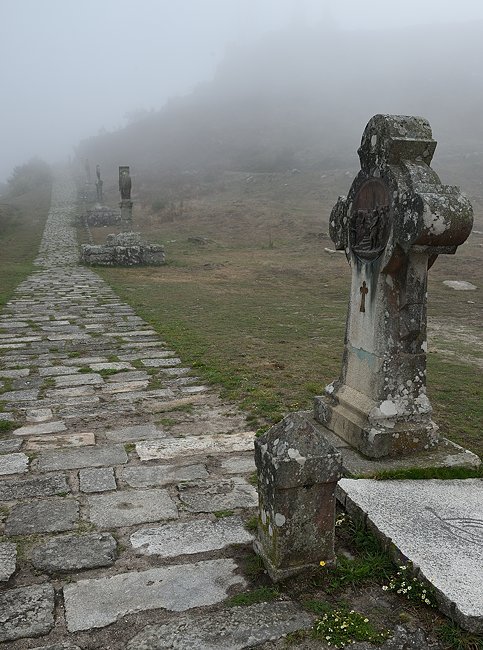
Which I did. This was my first rent-a-car trip in Europe. I still started with a long train trip — four-and-a-half-hours direct from Madrid Chamartin to Ourense — but there rented a six-speed, manual transmission, made-in-Spain Seat coupe to continue my journey to the coast on route A-52.
This post’s lead photo and the shot two paragraphs up were snapped in the cool fog blanketing Mount Santa Trega in A Guarda, yodeling distance from both the Atlantic and Portugal border. The crosses are relatively recent, sculpted by Valencian Vincent Mengual to replace a line of simpler crosses installed in the sixteenth and seventeenth century. The circular stone foundations are much older: the ancient Castro people settled this peak in the first century (as shown on page two of this big .pdf), likely chose the spot to monitor doings on the river Miño far below.
I watched several tour buses chug their way up steep Mount Santa Trega, and read that a TripAdvisor contributor hiked up from the base in less than an hour. That said, I know of no conventional transit route up the mountain, or, for that matter, to A Guarda itself. I don’t know how I could have come here without a car.
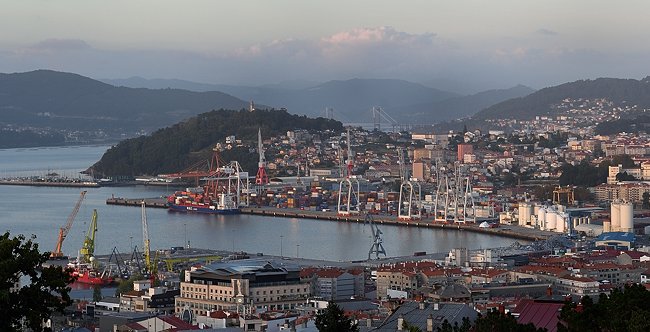
From Mount Santa Trega, I motored to a hotel I had thoughtlessly booked in the heart of the the port city shown above: Vigo. I write ‘thoughtlessly’ not because I objected to Vigo, but because I had somehow pictured it as a sparsely-populated whistle stop, easily navigated by an out-of-practice driver.
Wrong! Vigo is the biggest burg in Galicia, home to some 300,000 Gallegos, arguably Galicia’s economic engine. Further, I had booked a hotel on a central stretch of Rúa Lepanto, a metropolitan main drag. A carless moi could have strolled unstressfully to the hotel in a quarter hour from the Vigo train station, with nary a glance at the gated driveway to the hotel’s underground parking lot. Instead I had to contend with an interminable, clenched teeth stop-and-go past a major Rúa Lepanto construction project, and then circle blocks for a parking space so I could hunt up a hotel staffer to open the gate to the garage. Yuck.
I knew Vigo from Mondays in the Sun, an excellent 2002 film about the impact of shipyard closures on the Galicia coast. Mondays is grim, but I thought that Vigo offered a surprisingly lively, cheery vibe, and a lovely stroll in the hilltop Mount Castro Park, where I snapped this photo.
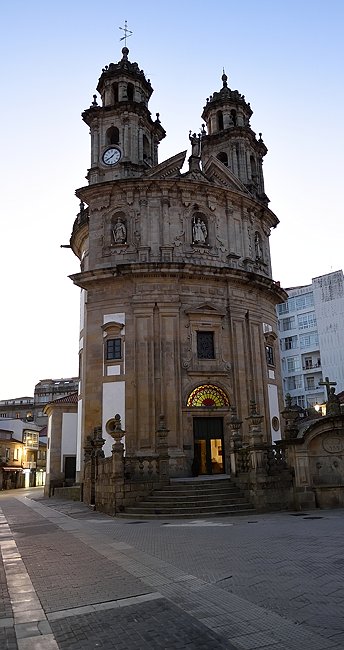
Next stop: Pontevedra, a smaller coastal city about 30 kilometers north, which I felt a bit embarrassed to visit as a motorist. Pontevedra mayor Miguel Anxo Fernández Lores banned almost all auto traffic from the medieval city center after gaining office in 1999. Better air quality, fewer accidents, friendlier to kids, and an allure strong enough to attract twelve thousand new Pontevedra residents. Absolutely the way to go, in my unbashful opinion. (What else would you expect me to write?)
I had no trouble docking my steed in an aparcamiento on the outskirts of town, and from there walked blissfully carfree streets to explore Pontevedra proper. Unfortunately, I had arrived in the wee hours on a Saturday morning, with a full slate of villages to visit in the day ahead. (Spaniards had offered many Galicia recommendations.) No time to linger.
I fetched the Seat from the parking garage, continued to:
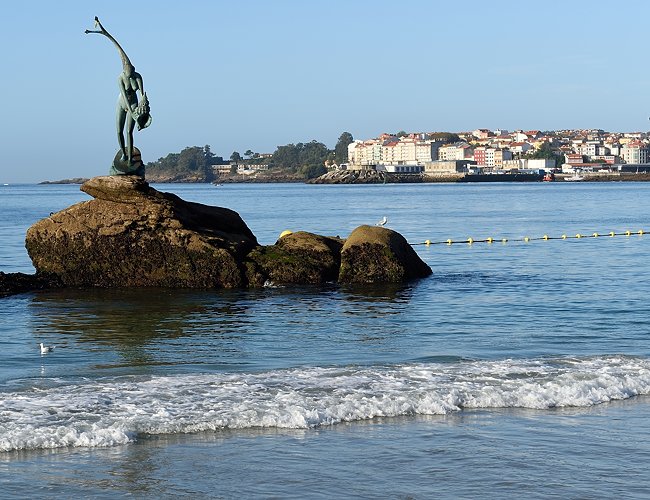
(♦) cozy, waterfront Sanxenxo, which furnished the shot above, is reportedly a fave of former Spain prime minister Mariano Rajoy and which Americans likely have never heard of;
(♦) Villagarcía de Arousa, which Americans likely have never heard of, either, and finally …
(♦) Santiago de Compostela, Galicia’s top tourist destination, which many Americans emphatically have heard of. A third of a million earthlings journeyed here in 2018 alone as the final stop of the Camino de Santiago, or the Way of Saint James.
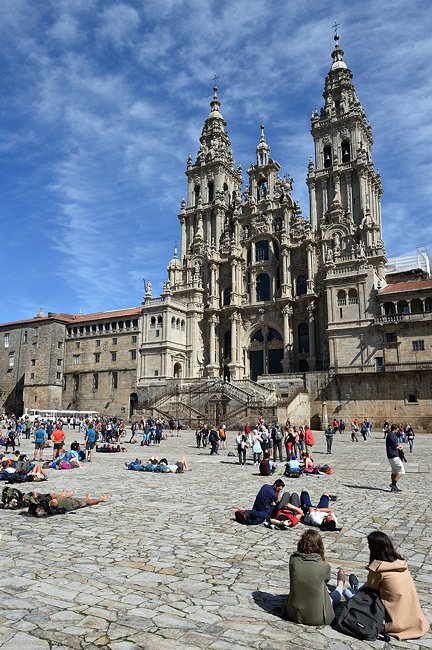
More than a billion of your fellow homo sapiens identify as Catholic. Like Muslims, Jews, Buddhists, believers of other faiths, they regard some places, things and people as more significant than others.
Contrast Santiago de Compostela to (oh, let’s see … ) the Extended Stay America hotel in Tracy, California, where I holed up while awaiting my Spain visa in 2016. Pope Francis has had nothing to say about this Extended Stay in papal speeches, and I spotted no walking-staff-toting peregrinos on hand for the hotel’s muffins n’ coffee breakfast buffet. The Tracy Extended Stay rates as strictly Unhallowed turf in Catholic canons, despite my agreeable memories of my stay there.
Santiago de Compostela: different story. Legend suggests that the Santiago de Compostela Cathedral houses the tomb of apostle Saint James. Catherine of Aragon reportedly prayed here for James’ other-worldly assistance in the sixteenth century. (Or so claims this site. Might even be true!) Pilgrims had begun Santiago de Compostela treks by the ninth century; they picked up Galician scallop shells to prove they’d completed the hike, helped make the shell a pilgrimage symbol. Their modern-day scions may complete the Camino on routes as short as 100 kilometers, or as long as 960.
Not all are Catholics. I know two non-believers who made the trek and sang high praises afterward for the fraternal spirit felt in the pilgrimage’s trails and hostels.
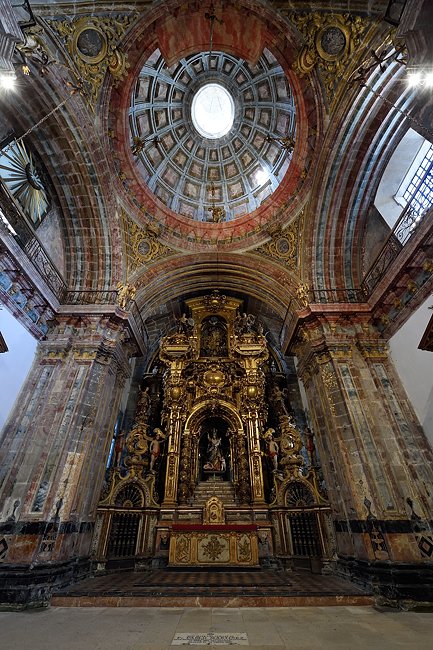
Santiago de Compostela offers plenty to see, especially for culture buffs. What I most remember now, though, are all those pilgrims: hardy, friendly, cheerful, mostly young and middle-aged, toting backpacks, walking sticks, no-nonsense safari hats. They milled sociably on the narrow lanes surrounding the cathedral, or sprawled on the worn-by-a-thousand-footsteps stones of the Plaza del Obradoiro fronting the cathedral, backpacks now serving as headrests as they gazed serenely up at the cathedral they’d trekked for days and days to see.
Any negatives? One: I had my usual rotten luck with online eatery recommendations, walked a kilometer to the Happy Cow recommended TS-A Casa only to discover that the listed hours were wrong. Closed. Shucks. I wound up buying food at the off-the-tourist track DIA market on Rúa de San Roque, where I noted that most locals chatted in Gallego, rather than Spanish. Reading reports of this language’s use in Galicia hadn’t impressed as much as hearing the lingo with my own ears, and seeing it printed in Galician newspapers.
Galicia’s famous rain returned the next day. I drove to A Coruña, stared past madly oscillating windshield wipers at the famous Tower of Hercules, couldn’t talk myself into a walk through the downpour to stand next to it. I hit the road again for the longest drive of the trip, a three hour freeway shlep to Gijón. (Which Spaniards will correctly note is outside of Galician limits, in the neighboring autonomous community of Asturias.) The rental agency got its Seat back; I rode transit back to Madrid.
Some takeaways from my first Europe trip behind a steering wheel:
(♦) I’m glad I found this Guardian article about car hire, which includes a list of top-rated firms. Rental pick up and return differed little from norms in the U.S., although all chat was in Spanish.
(♦) Europeans like to shift gears. Expect to choose among many cars with manual transmissions, and one or two bloated, full-size models with automatics.
(♦) Even Koch Brothers admirers may want to favor inky-dinky sized car rentals in Europe. Expensive gas is one factor. The other: narrow streets. After one wrong turn, the navigator sent me down an alley likely crafted for horse carts during the Carlist Wars. My compact made it through, but barely.
(♦) I paid extra to rent a dated Garmin GPS, but soon ditched it for the familiar Google Maps smartphone navigator, despite my unhappiness about signing in to Google’s de facto international surveillance system. The navigator has always impressed me, but dealt less gracefully with long Spanish street names in roundabouts than with straightforward, left and right turns in U.S. intersections. In California, I rarely fumbled an instruction like “turn right on Parkside.” In Galicia, it was more like “at the roundabout, take the third exit to Rúa de Fernando Conde” … with the longish ‘Rúa de Fernando Conde’ squeezed onto the Spain street sign in a small font, and spoken with the robotic navigator’s bubbly American accent.
The result, for me, at least: wrong turns. Lots of them. Spain is chock full of multiple-exit roundabouts, as noted in my post about qualifying for a Spain drivers’ license. I learned to pay much more attention to the navigator graphic than I had in the states, and had improved by the third day, but will still expect similar errors on future rent-a-car trips in the Old World.
(♦) Lots of unstaffed, mechanized toll roads, encountered without advance warning from the navigator. I paid with my Spain credit card.
(♦) Freeway driving is similar to the equivalent in the U.S. Expect to find easy-off/easy-on gas station/restaurant complexes, as on freeways in California. Freeways also struck me as spiffier and better attended to than equivalents remembered in the states. (See the note above about toll roads.)
(♦) Urban driving in Europe struck me as tougher than in the U.S. I regret booking a hotel in downtown Vigo, am grateful that I scouted parking garages near city outskirts, so I could leave the Seat there to continue to city centers on foot.
Q: Why can’t I see high-res photos when I click on the snaps above?
A: ‘Cause I don’t want to have to back up huge .jpg files in WordPress, and would rather gently ask you to view them in the directory listing, as follows:
https://transitophile.com/chango/files/galicia/
Please find the photo you want to view, make with the mouse.
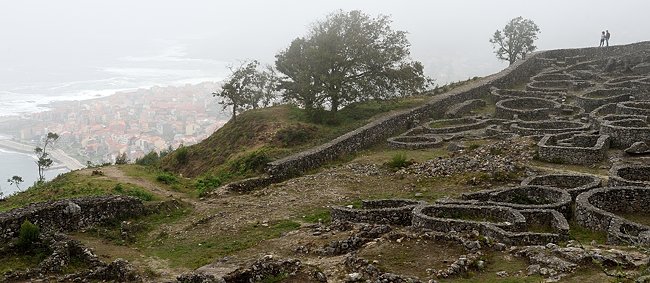
Beautiful photos of a beautiful place
Thank you, Imelda!